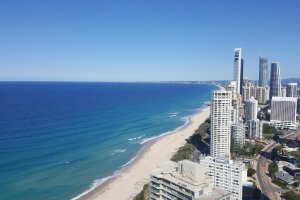Gold Coast High-Rise Apartments to Triple due to Densification

Gold Coast High-Rise Apartments to Triple due to Densification
With its housing affordability nipping at the heels of Australia’s most expensive city and its developable land drying up, the future of the Gold Coast skyline is looking a lot busier and more crowded.
High-rise apartments are expected to make up more than 60% of the fast-growing city’s future housing supply as its densification ramps up over the next two decades.
“At the moment, across the Gold Coast, we have about 10% of the built form is high-rise,” CoreLogic research director Tim Lawless said. “By 2046, that’s going to be 30%.”
Of the 162,000 new homes forecast under the new Southeast Queensland Regional Plan to be built on the coastal strip during the next 12 years, 62% are expected to be high-rise apartments and only 11% detached homes.
Lawless said the trend was already evident in the housing approval data with lower density approvals tracking consistently down as land becomes increasingly scarce on the Gold Coast.
“The landscape of this region is fundamentally starting to change,” he said.
In the 12 months to the end of 2023, apartment developments made up 61.6 per cent of approvals, while semi-detached and detached housing equated to 15.5% and 22.9%, respectively.
Speaking at a Property Council of Australia housing outlook event on the Gold Coast, Lawless said despite its strong growth fundamentals, one of the city's biggest challenges moving forward was housing affordability—home values have soared “50-odd per cent” since the pandemic.
“If you're a homeowner in this region, you've seen a pretty decent wealth injection,” he said. “The median value of a house on the Gold Coast is now over $1 million.
“It’s higher than Brisbane, it’s higher than Melbourne—it’s getting closer to Sydney.”
Lawless said Gold Coast house prices were still 20% lower than Sydney prices but crunching the numbers on an income-adjusted basis, the ratio of housing values to household incomes was “almost identical”.
CoreLogic data showed that 9.3 times the annual median household income was needed to buy a median-priced home on the Gold Coast.
By comparison, the price of home ownership in Sydney is only marginally higher at 9.4 times the median-household income.
Sitting above both cities, due to its lower income base, is the Sunshine Coast, where 10.7 times the median annual household income was needed to buy a median-priced home.
“This is a marketplace, southeast Queensland quite broadly, that's really been leading the nation in terms of value growth,” Lawless said.
However, he said, such rapid value growth “does have a very negative downside ...[because] household incomes haven't grown anywhere near this fast”.
“Coming into the pandemic, the Gold Coast was actually a lot more affordable,” Lawless said.
But he said since 2020 the city had been through “this spectacular rate of growth and has seen extreme levels of capital growth since 2020—right up there with the late 80s and early 90s …and eclipsing what was seen back in the early 2000s”.
“Affordability constraints are becoming much more pressing.
“And so you have to think with ... a bigger hurdle to get into the marketplace, that's going to have to impact on who's coming to the Gold Coast. If it’s too expensive, people will just stop coming.”
Nevertheless, he noted: “Despite very high interest rates, the cost-of-living crisis and worsening affordability pressures, we're still seeing the volume of sales, the demonstrated demand in the marketplace holding at around decade average levels …[albeit] well down from the height of the pandemic”. And “This is really surprising to me,” Lawless said.
That becomes even more counterintuitive, he said, when you look at the city’s housing supply levels.
Thanks to its lower income base, 10.7 times the median annual household income is needed to buy a median-priced home on the Sunshine Coast.
“We’ve been tracking listings since 2006 and we’ve never seen available stock in the Gold Coast marketplace as low as what it is at the moment—just a little bit less than 4000 homes advertised for sale over the past month … [and] a little bit over two months’ supply, which is remarkably low.
“It’s one of the key reasons we’ve seen this upward pressure on housing prices.”
Compounding the situation is what he described as “a pretty sharp drop” in the volume of higher density development approvals as well as a consistent reduction in lower density detached housing approvals.
“The jaws have massively opened up here in terms of undersupply, there's been no response from the supply perspective to this record level of demand coming into the market.”
And, significantly, pointing to the Gold Coast’s population growth projections, he said: “It doesn’t look like that demand side is going to be changing very much at all.
“I wouldn’t quite call this the epicentre of population growth but … the raw numbers of people coming into the Gold Coast over the next 10 years, let alone from now to 2046, is absolutely huge.
“It’s going to be the biggest growth market in terms of population … there’s no other market that has stronger fundamentals than this.
“The other side to that is there’s not many other markets that have the same sort of challenges, the worsening affordability like what we're seeing here on the back of strong price growth, and very clear geographic supply side restrictions.”
Source: Phil Bartsch (Author); TUD.
